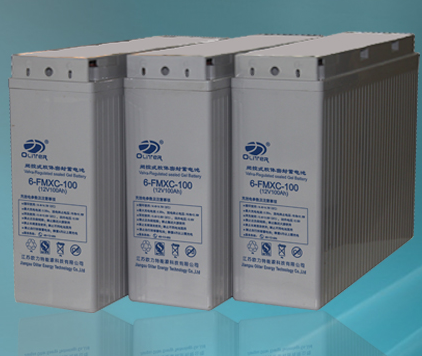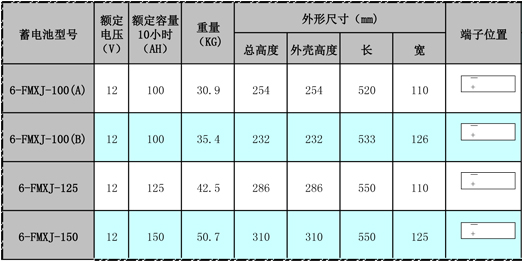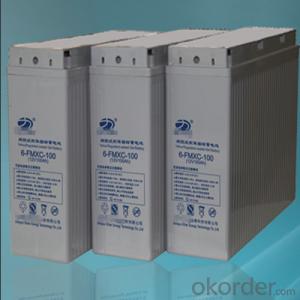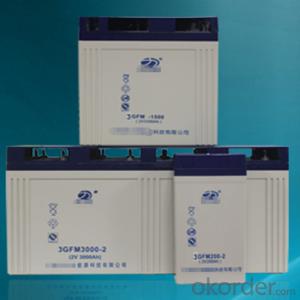Colloidal Battery 12 v series of communication
- Loading Port:
- China main port
- Payment Terms:
- TT or LC
- Min Order Qty:
- 1 pc
- Supply Capability:
- 10000 pc/month
OKorder Service Pledge
OKorder Financial Service
You Might Also Like
Structure of Product Descrtption:
What is the product?
The FMXA/FMXC (Front Terminal) Series is especially designed for telecommunication use with 12 years design life in float service. By combining the newly developed paste formula with up-to-date AGM structures, this range features 12 years design life and Front Access connection for fast, easy installation and maintenance. This series is highly suited for telecom applications, UPS systems and other back up applications.
What is the purpose of the product?
· Telecommunication
· Control Equipments
· UPS systems
· Communication Equipments
· Medical Equipments
· Emergency Power Systems
What advantages do products have ?
12 years design life at floating condition
Wide operating temperature range from -15°C to 55°C
Advanced paste formula with increased recharge efficiency
Front access terminal with standard width for 19” and 23” ETSI racks
30% decreased float current lead to excellent high temperature resistance
Thick flat plate with high Tin low Calcium alloy
Low self discharge
Excellent deep discharge recovery capability
Main feature of the product
*safety and reliable
*environmental friendly and fast delivery
*low self diacharge


FAQ:
*Question:How do you pack your products?
Answer:We have rich experience on how to pack the panels to make sure the safety on shipment when it arrives at the destination.
*Question:Can you do FOB for us?
Answer:Yes, we can do it for you .
*Question:How long can we receive the goods after purchase?
Answer:In the purchase of product within three working days, We will arrange the factory delivery as soon as possible. The perfect time of receiving is related to the state and position of customers. Commonly 7 to 10 working days can be served.
Principles of how solar cell works
Solar power is amazing. On average, every square meter of Earth's surface receives 164 watts of solar energy. In other words, you could stand a really powerful (150 watt) table lamp on every square meter of Earth's surface and light up the whole planet with the Sun's energy! So, we want to exploit resources, and solar (or photovoltaic) cells appearance, it converts the sun’s energy into electricity. Whether they’re adorning your calculator or orbiting our planet on satellites, they rely on the the photoelectric effect: the ability of matter to emit electrons when a light is shone on it.
Steps of how solar cell works
Sunlight is composed of miniscule particles called photons, which radiate from the sun. As these hit the silicon atoms of the solar cell, they transfer their energy to loose electrons, knocking them clean off the atoms. The photons could be compared to the white ball in a game of pool, which passes on its energy to the coloured balls it strikes.
A solar cell is a sandwich of two different layers of silicon that have been specially treated or doped so they will let electricity flow through them in a particular way. The lower layer is doped so it has slightly too few electrons. It's called p-type or positive-type silicon (because electrons are negatively charged and this layer has too few of them). The upper layer is doped the opposite way to give it slightly too many electrons. It's called n-type or negative-type silicon.
The electrons use this energy to jump across the barrier into the upper, n-type layer and escape out into the circuit. Flowing around the circuit, the electrons make the lamp light up.
Energy Loss in a Solar Cell when it is working
Visible light is only part of the electromagnetic spectrum. Electromagnetic rad­iation is not monochromatic -- it's made up of a range of different wavelengths, and therefore energy levels.
Light can be separated into different wavelengths, which we can see in the form of a rainbow. Since the light that hits our cell has photons of a wide range of energies, it turns out that some of them won't have enough energy to alter an electron-hole pair. They'll simply pass through the cell as if it were transparent. Still other photons have too much energy. Only a certain amount of energy, measured in electron volts (eV) and defined by our cell material (about 1.1 eV for crystalline silicon), is required to knock an electron loose. We call this the band gap energy of a material. If a photon has more energy than the required amount, then the extra energy is lost. (That is, unless a photon has twice the required energy, and can create more than one electron-hole pair, but this effect is not significant.) These two effects alone can account for the loss of about 70 percent of the radiation energy incident on our cell.
- Q:Can solar cells be used in countries with limited sunlight?
- Yes, solar cells can still be used in countries with limited sunlight. While solar cells generate the most electricity under direct sunlight, they can still generate power even in cloudy or overcast conditions. Additionally, advancements in solar panel technology have made them more efficient in capturing diffuse sunlight, enabling their use in regions with limited sunlight.
- Q:What is the impact of solar cells on reducing air pollution from power generation?
- Solar cells have a significant impact on reducing air pollution from power generation. By harnessing the sun's energy, solar cells produce clean electricity without emitting harmful pollutants like carbon dioxide and other greenhouse gases. This reduces the reliance on fossil fuels, which are major contributors to air pollution and climate change. Additionally, solar cells help to decrease the release of other harmful pollutants, such as sulfur dioxide and nitrogen oxides, which are commonly emitted during traditional power generation. Overall, the widespread adoption of solar cells can greatly contribute to improving air quality and mitigating the adverse effects of power generation on the environment.
- Q:Can solar cells be used in desert environments?
- Yes, solar cells can be used in desert environments. In fact, desert environments are ideal for solar power generation due to abundant sunlight. The high solar irradiance levels in deserts provide excellent conditions for solar panels to generate electricity efficiently. Additionally, solar panels can withstand the extreme heat and sandstorms typically found in desert regions.
- Q:Can solar cells be used to power remote wildlife monitoring systems?
- Yes, solar cells can be used to power remote wildlife monitoring systems. Solar cells are a sustainable and reliable source of energy that can generate electricity from sunlight, making them ideal for powering remote systems where access to the grid may be limited. Additionally, solar cells are environmentally friendly, allowing for uninterrupted monitoring of wildlife without causing harm to their habitats.
- Q:How do solar cells perform in areas with high levels of pollen allergies?
- Solar cells can generally perform well in areas with high levels of pollen allergies. While the presence of pollen might lead to some dust accumulation on the surface of the solar panels, it does not significantly impact their performance. Regular cleaning and maintenance can help ensure optimal efficiency of the solar cells, even in areas with high pollen levels.
- Q:Can solar cells be used for powering remote sensing devices?
- Yes, solar cells can be used for powering remote sensing devices. Solar cells convert sunlight into electricity, making them an ideal power source for remote sensing devices that are often located in areas without access to traditional power grids. Additionally, solar cells are renewable and environmentally friendly, making them a sustainable option for powering these devices.
- Q:What is the impact of algae growth on solar cell performance?
- The impact of algae growth on solar cell performance is generally negative. Algae growth can block sunlight from reaching the solar cells, reducing their efficiency and energy output. Additionally, algae can cause corrosion and damage to the surface of solar panels, further compromising their performance. Regular cleaning and maintenance are necessary to prevent algae buildup and ensure optimal solar cell performance.
- Q:Can solar cells be installed on any type of roof?
- Yes, solar cells can be installed on almost any type of roof, including flat roofs, sloped roofs, metal roofs, tile roofs, and even asphalt shingle roofs. However, the specific installation process may vary depending on the type of roof and its structural integrity. It is always recommended to consult with a professional solar installer to assess the feasibility of installation on a particular roof type.
- Q:What is a polycrystalline solar cell?
- A polycrystalline solar cell is a type of solar cell made from multiple small silicon crystals, unlike a monocrystalline solar cell which is made from a single crystal. This manufacturing process makes polycrystalline solar cells less expensive to produce, although they typically have slightly lower efficiency compared to monocrystalline solar cells.
- Q:What is the impact of fire hazards on solar cells?
- The impact of fire hazards on solar cells can be significant and detrimental. Fires can cause direct damage to the cells, resulting in their complete destruction or impaired performance. The high temperatures and flames associated with fires can melt or warp the delicate components of solar cells, rendering them useless. Additionally, the smoke and ash produced by fires can settle on the surface of the solar panels, reducing their efficiency by blocking sunlight. Therefore, fire hazards pose a significant risk to the functionality and longevity of solar cells.
1. Manufacturer Overview |
|
|---|---|
| Location | |
| Year Established | |
| Annual Output Value | |
| Main Markets | |
| Company Certifications | |
2. Manufacturer Certificates |
|
|---|---|
| a) Certification Name | |
| Range | |
| Reference | |
| Validity Period | |
3. Manufacturer Capability |
|
|---|---|
| a)Trade Capacity | |
| Nearest Port | |
| Export Percentage | |
| No.of Employees in Trade Department | |
| Language Spoken: | |
| b)Factory Information | |
| Factory Size: | |
| No. of Production Lines | |
| Contract Manufacturing | |
| Product Price Range | |
Send your message to us
Colloidal Battery 12 v series of communication
- Loading Port:
- China main port
- Payment Terms:
- TT or LC
- Min Order Qty:
- 1 pc
- Supply Capability:
- 10000 pc/month
OKorder Service Pledge
OKorder Financial Service
Similar products
New products
Hot products
Related keywords



























